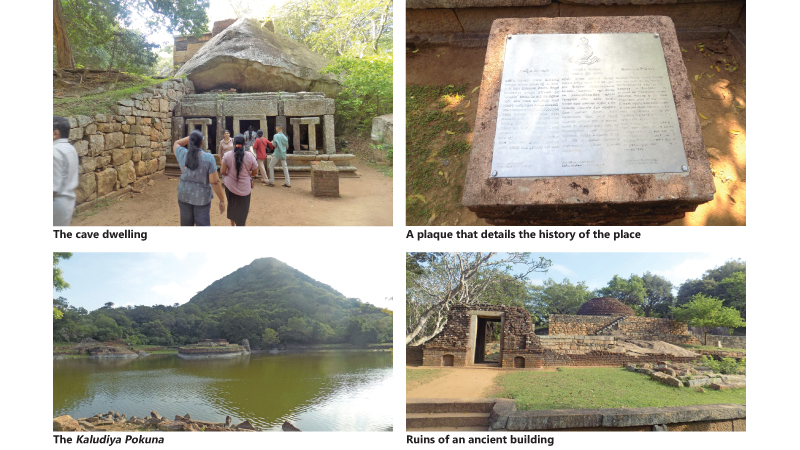Sri Lanka is endowed with beautiful ruins from millennia ago. When we visit these amazing sites, we realise the architectural genius of ancient engineers who built these constructions. The Kaludiya Pokuna at Mihintale is one such place.
When you travel from Mihintale towards Kandy, you will see a monastery complex with the Kaludiya Pokuna at Galkulama on your left at the foot of the Western slopes of Mihintale. The Kaludiya Pokuna measures approximately 200 feet in length and 70 feet in width. It is surmised that this pond amid a vast complex nestled among dense foliage, may have been used for the observance of Pohoya Karma which involves the operational rules of the monastic community.
The complex consisting of the Kaludiya Pokuna or Black Pond is an ancient Buddhist Monastery established in the 2nd century B.C E. during the Anuradhapura era.
The Kaludiya Pokuna is the largest one among several ponds such as Sinha Pokuna, Naga Pokuna and Katuseya Pokuna in Anuradhapura. According to folklore, Ven. Kalu Buddha Rakkitha Arahat Thera delivered a sermon based on the Kalakarama Sutta while being seated on a granite seat under a dark Thimbiriya tree near the Kaludiya Pokuna. King Saddhatissa too had come to listen to the sermon. Here is a folk song woven around this incident.
Gal gigirangalgigirangalketiya
Mal gigiran mal gigiran mal ketiya
Kaluthimirata pitadeela wedasitiya
Kaludiya Pokuna balanna deviyoth wediya
(Among the golden rocks and golden flowers, the Thera seated under a black Thimbiri tree. Even the Gods came to see the Kaludiya Pokuna)
It is said that the name Kaludiya Pokuna evolved out of respect for the sombre reflections of trees and boulders of the neighbouring forests and mountains.
Amongst its serenely beautiful forest and boulder clad environs, we find some of the earliest examples of Sinhalese hydraulic civilisation.
Artificial moats running through some of the buildings, the bathhouses and the toilets within the buildings of the complex are witness to an advanced hydraulic civilisation.
Most experts believe that the Kaludiya Pokuna may probably be the ancient Porodini Pokuna mentioned in the inscription of King Mahinda IV, at Mihintale. Around the pond, there are remnants of a monastery consisting of a Stupa, Uposathagara, Poya Ge, the building where bhikkhus met at regular intervals to perform certain rituals pertaining to their conduct and behaviour, Chankamanapaths, Residential cells, Jantaghara, a Bath house and toilets.
A cave dwelling found in a slight depression in the vicinity is a notable feature. Tucked cosily under a massive overhanging of a boulder, smooth granite slabs and bricks are blended together to form the enclosing walls, instead of the usual brick and mortar.
Some scholars believe that this would have been a bathing house attached to a bathing pokuna in front, now silted up.
There are several moats connected to the Pokuna that direct the flow of water from the pond. The well designed site had met all the needs for a monastic existence.
In recognition of its historical and architectural significance, the land surrounding the Kaludiya Pokuna was declared as an archaeological reserved area in 1926.
When we walked along the paths under the shady trees of the site, we noticed monkeys chattering and eating fruits. Tropical birds were also seen in abundance.






